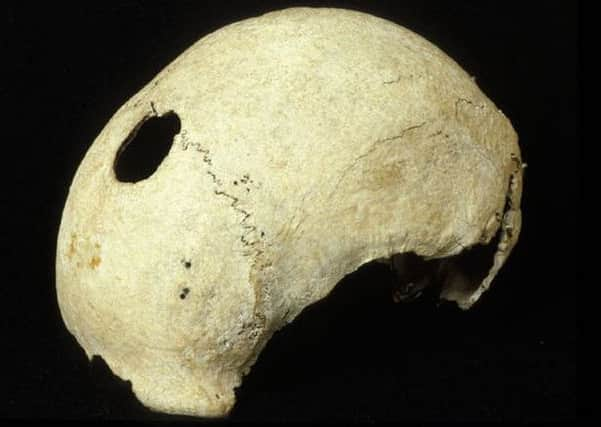Culloden battle skull scanned in 3D as anniversary approaches


As the 270th anniversary approaches, archaeologists from conservation charity the National Trust for Scotland have joined with The Royal College of Surgeons of Edinburgh to apply the latest technology to one of its unfortunate victims.
The top section of a skull of what is thought to be someone who met their demise on the battlefield has been on display at The Royal College of Surgeons of Edinburgh’s Hall Museums in Nicolson Street for many years.
Advertisement
Hide AdAdvertisement
Hide AdA digital 3D model of the skull has been created using overlapping digital photography.
The museum catalogue entry at the museum simply stated: “The skull was found on that part of the field at Culloden where the Highlanders, wrapping their plaids about their left arms, and stooping low made their attack on the King’s troops.”
The top of the skull clearly shows evidence of an entry wound of a projectile just left of centre with a larger exit wound at the back lower right.
The 3D modelling technology essentially overlays standard photographs which can be then be used to create 3-D images and models – these remove the need to transport the original, fragile human remains around for the purposes of study and display.
Derek Alexander, Head of Archaeological Services for the National Trust for Scotland, said: “We cannot say whether the skull fragment belongs to a Jacobite or one of the Government troops but the injury to the top of the head could be interpreted in a number of different ways.
“It could be from someone, head down, looking at the ground as they charge forward, or an individual who has already been wounded and is on their hands and knees or indeed it could be someone hit while focussing on reloading their musket.”
Given the impact, the musket ball was probably fired from about forty-five metres away.
Advertisement
Hide AdAdvertisement
Hide AdThe skull came to the Museum as part of a large collection of over 3000 items purchased from Sir Charles Bell in 1825.
There are no further details from Bell’s original records as to when he acquired it, but it is established that artefacts were collected from the battlefield in the years following the events of 16 April 1746.
The Statistical Account for Scotland published around 1794 mentions that “bullets and fragments of armour that are picked up by people in the neighbourhood are anxiously sought after and preserved by the virtuosi as curiosities and valuable relics”.
The good preservation condition of the skull suggests it had not been exposed to the elements or buried for long before it made its way into someone’s anatomical collection.
The skull is well-known in medical circles and is on display with other examples of skeletal remains that display evidence of battlefield trauma, although most of these are from later periods such as the Napoleonic Wars.
In order to understand the skull better and for the information to be used at the Culloden battlefield centre, archaeologists have been working on a digital 3D model of the skull using photogrammetric techniques.
Stefan Sagrott, Archaeology Data Officer for the National Trust for Scotland, said: “Photogrammetry is a great tool for us, especially because it is low cost and doesn’t require any fancy equipment aside from a decent camera and the processing software.
Advertisement
Hide AdAdvertisement
Hide Ad“We are using it to record a whole range of cultural heritage sites, monuments and artefacts, and we are getting some really outstanding results.
“By using it to record cultural heritage, it allows us to open up the past to even more people than ever before. We can take an object which would be too fragile for anyone to handle, photograph it, 3D model it and then make it available online for anyone to see, wherever they are.
“Another brilliant result of this, is that we can also 3D print the models, creating accurate replicas of objects, such as the Culloden skull, and they can then be displayed at a property and handled without any worry of damaging the original object.”
Derek Alexander added: “We are really grateful to the Surgeons’ Hall Museums for providing access to the skull and for working in partnership with us.
“The skull is a unique example of human remains from Culloden and graphically demonstrates the horrific wounds that would have been suffered by both the Jacobite and Government armies as a result of close quarter musketry.”
Rohan Almond, Assistant Curator at Surgeons’ Hall Museums, said: “Whilst we had known the skull had come from the battlefield at Culloden, we had no idea of its unique nature and are very excited to be taking part in this project.
“By working together and using such technology, we are going to be able to engage even more people in the story of one of Scotland’s pivotal battles.”
Advertisement
Hide AdAdvertisement
Hide AdKatey Boal, Learning Manager at the National Trust for Scotland’s Culloden Battlefield and Visitor Centre said:
“A skull is an incredibly personal thing, when you look at it in 3 dimensions you can imagine the person it would have belonged to.
“This skull takes the story of Culloden and reminds us that real people were involved, they fought, suffered and died on the field.
“It is a huge responsibility to tell their story, and the work the team has done is an important part of that.”
As part of a series of events and commemorations to mark the 270th anniversary of the battle, the results of the photogrammetric modelling of the skull will be presented By Derek Alexander, along with further archaeological work at other National Trust for Scotland properties on the Jacobite uprisings, at the Culloden Visitor Centre 15 April.
There will also be a talk about battlefield pathology at Surgeons’ Hall Museums in Edinburgh in July which will include the Culloden skull.